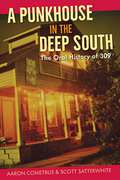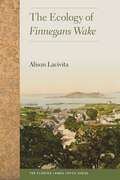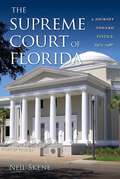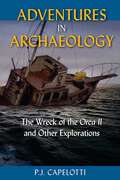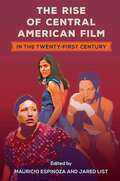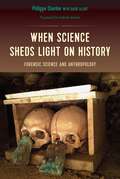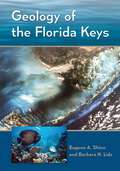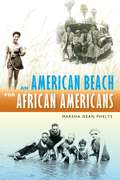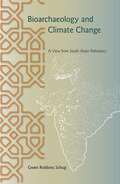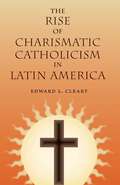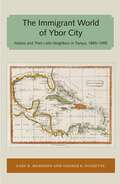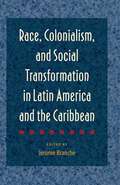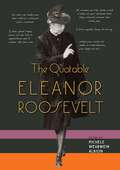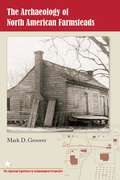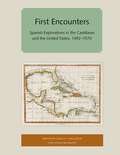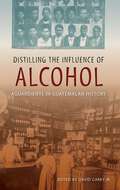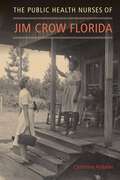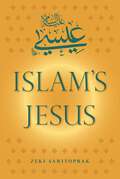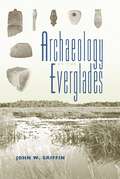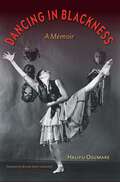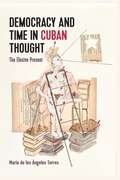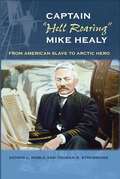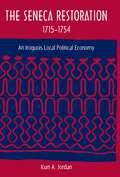- Table View
- List View
A Punkhouse in the Deep South: The Oral History of 309
by Aaron Cometbus Scott SatterwhiteRadical subcultures in an unlikely place Told in personal interviews, this is the collective story of a punk community in an unlikely town and region, a hub of radical counterculture that drew artists and musicians from throughout the conservative South and earned national renown. The house at 309 6th Avenue has long been a crossroads for punk rock, activism, veganism, and queer culture in Pensacola, a quiet Gulf Coast city at the border of Florida and Alabama. In this book, residents of 309 narrate the colorful and often comical details of communal life in the crowded and dilapidated house over its 30-year existence. Terry Johnson, Ryan “Rymodee” Modee, Gloria Diaz, Skott Cowgill, and others tell of playing in bands including This Bike Is a Pipe Bomb, operating local businesses such as End of the Line Cafe, forming feminist support groups, and creating zines and art. Each voice adds to the picture of a lively community that worked together to provide for their own needs while making a positive, lasting impact on their surrounding area. Together, these participants show that punk is more than music and teenage rebellion. It is about alternatives to standard narratives of living, acceptance for the marginalized in a rapidly changing world, and building a sense of family from the ground up. Including photos by Cynthia Connolly and Mike Brodie, A Punkhouse in the Deep South illuminates many individual lives and creative endeavors that found a home and thrived in one of the oldest continuously inhabited punkhouses in the United States.
The Ecology of Finnegans Wake (Florida James Joyce)
by Alison LacivitaIn this book—one of the first ecocritical explorations of Irish literature—Alison Lacivita defies the popular view of James Joyce as a thoroughly urban writer by bringing to light his consistent engagement with nature. Using genetic criticism to investigate Joyce’s source texts, notebooks, and proofs, Lacivita shows how Joyce developed ecological themes in Finnegans Wake over successive drafts.Making apparent a love of growing things and a lively connection with the natural world across his texts, Lacivita’s approach reveals Joyce’s keen attention to the Irish landscape, meteorology, urban planning, Dublin’s ecology, the exploitation of nature, and fertility and reproduction. Alison Lacivita unearths a vital quality of Joyce’s work that has largely gone undetected, decisively aligning ecocriticism with both modernism and Irish studies.
Virginia Woolf, the War Without, the War Within: Her Final Diaries and the Diaries She Read
by Barbara LounsberryChoice Outstanding Academic Title In her third and final volume on Virginia Woolf’s diaries, Barbara Lounsberry reveals new insights about the courageous last years of the modernist writer’s life, from 1929 until Woolf’s suicide in 1941. Woolf turned more to her diary—and to the diaries of others—for support in these years as she engaged in inner artistic wars, including the struggle with her most difficult work, The Waves, and as the threat of fascism in the world outside culminated in World War II. During this period, the war began to bleed into Woolf’s diary entries. Woolf writes about Hitler, Mussolini, and Stalin; copies down the headlines of the day; and captures how war changed her daily life. Alongside Woolf’s own entries, Lounsberry explores the diaries of 18 other writers as Woolf read them, including the diaries of Leo Tolstoy, Dorothy Wordsworth, Guy de Maupassant, Alice James, and André Gide. Lounsberry shows how reading diaries was both respite from Woolf’s public writing and also an inspiration for it. Tellingly, shortly before her suicide Woolf had stopped reading them completely. The outer war and Woolf’s inner life collide in this dramatic conclusion to the trilogy that resoundingly demonstrates why Virginia Woolf has been called “the Shakespeare of the diary.” Lounsberry’s masterful study is essential reading for a complete understanding of this extraordinary writer and thinker and the development of modernist literature.
The Supreme Court of Florida: A Journey toward Justice, 1972-1987
by Neil Skene“A fascinating judicial study. The importance of the modern high court’s docket is so thoroughly and expertly chronicled in this book: reapportionment, courtroom cameras, personal injury, family law, environmental law, capital punishment, criminal justice, and equal justice under law.”—Thomas E. Baker, coauthor of Appellate Courts: Structures, Functions, Processes, and Personnel “A highly readable portrait of a crucial time in the history of the state high court. It brings to life the jurists and lawyers who contributed so much to contemporary Florida law.”—Mary Ziegler, author of After Roe: The Lost History of the Abortion Debate “A richly sourced, thoroughly researched, and entertaining account of one of the most significant eras in the history of what is arguably the most important (and least reported) branch of Florida government. Tells not only how the court’s decisions impact people’s lives but also how the personalities and life experience of new justices lead to evolutions in the law.”—Martin A. Dyckman, author of A Most Disorderly Court: Scandal and Reform in the Florida Judiciary “Necessary reading for anyone interested in law and politics in Florida. Makes historical figures come alive.”—Jon L. Mills, author of Privacy in the New Media Age This third volume in the history of the Florida Supreme Court describes the court during its most tumultuous years. Amid the upheaval of the civil rights movement, the Vietnam War, and Watergate, the story begins with reform in the Florida court system. It includes the court’s first black justice, Joseph Hatchett; Governor Reubin Askew’s new system for merit selection of justices; and revision of Article V, the section of the state constitution dealing with the judiciary. Neil Skene details landmark court decisions; the introduction of cameras in court; changes to media law, personal injury law, and family and divorce law; privacy rights; gay rights; death penalty cases; and the appointment of the first female justice, Rosemary Barkett. Shining a light on the often invisible work that informs the law, Skene recognizes lawyers and lower-court judges whose arguments and opinions have shaped court rulings. He integrates firsthand stories from justices with documents, articles, and cases. The result is an absorbing portrayal of a judicial institution adapting to a turbulent time of deep political and social change.
Adventures in Archaeology: The Wreck of the Orca II and Other Explorations
by P.J. CapelottiRemnants of the curious and peculiar ways humankind has marked the archaeological landscape are abundant but often ignored: wrecked aircraft, abandoned airfields, old highway billboards, derelict boats, movie props, and deserted mining operations. In this book, archaeologist P.J. Capelotti explores places and things that people do not typically think of as archaeological sites and artifacts, introducing readers to the most extreme fieldwork taking place today. Capelotti shows that even seemingly ordinary objects from the recent past hold secrets about the cultural history of humans. He investigates the site where a stunt copy of the Orca, the fishing boat used in the movie Jaws, was stripped to pieces by fans—a revelation of the ways humans relate to popular culture. He takes readers to abandoned base camps near the North Pole that are now used as destinations for Arctic tourism. Retelling the story of Thor Heyerdahl’s research expedition across the Pacific Ocean on a balsa log raft, Capelotti shows how experimental archaeology attempts to reveal cultural connections between continents. And he doesn’t stop at the limits of the planet. He discusses debris floating through outer space and equipment left behind on the surface of the moon, highlighting current efforts to preserve artifacts that exist beyond the Earth’s atmosphere. These discarded materials, says Capelotti, help archaeologists piece together the sweeping story of human cultural expansion and exploitation. He explains how the unusual sites of shorelines, sea, air, and space represent the farthest reaches of human civilization. His enthusiasm will inspire readers to set out on their own to investigate the secret meanings of treasures hiding in plain sight.
The Rise of Central American Film in the Twenty-First Century (Reframing Media, Technology, and Culture in Latin/o America)
by Mauricio Espinoza Jared ListHow an overlooked film industry became a cinematic force The first book in English dedicated to the study of Central American film, this volume explores the main trends, genres, and themes that define this emerging industry. The seven nations of the region have seen an unprecedented growth in film production during the twenty-first century with the creation of over 200 feature-length films compared with just one in the 1990s. This volume provides a needed overview of one of the least explored cinemas in the world. In these essays, various scholars of film and cultural studies from around the world provide insights into the continuities and discontinuities between twentieth- and twenty-first-century cinematic production on the Isthmus. They discuss how political, social, and environmental factors, along with new production modes and aesthetics, have led to a corpus of films that delve into issues of the past and present such as postwar memory, failed revolutions, trauma, migration, popular culture, minority populations, and gender disparities. From Salvadoran documentaries to Costa Rican comedies and Panamanian sports films, the movies analyzed here demonstrate the region’s flourishing film industry and the diversity of approaches found within it. The Rise of Central American Film in the Twenty-First Century pays homage to an overlooked cultural phenomenon and shows the importance of regional cinema studies.Contributors: Liz Harvey-Kattou | Daniela Granja Núñez | Carolina Sanabria | Juan Carlos Rodríguez | María Lourdes Cortés | Júlia González de Canales Carcereny | Arno Jacob Argueta | Tomás Arce Mairena | Dr. Mauricio Espinoza | Lilia García Torres | Dr. Jared List | Patricia Arroyo Calderón | Esteban E. Loustaunau | Héctor Fernández L'Hoeste | Juan Pablo Gómez Lacayo | Jennifer Carolina Gómez Menjívar A volume in the series Reframing Media, Technology, and Culture in Latin/o America, edited by Héctor Fernández L’Hoeste and Juan Carlos Rodríguez Publication of this work made possible by a Sustaining the Humanities through the American Rescue Plan grant from the National Endowment for the Humanities.
When Science Sheds Light on History: Forensic Science and Anthropology
by Philippe Charlier"Well written and hard to put down. For anyone with an interest in forensic science, this book is a must-read."--Nigel McCrery, author of Silent Witnesses: The Often Gruesome but Always Fascinating History of Forensic Science "This compilation is a fascinating read for the nonspecialist and will further serve as an inspirational set of recommended readings for the next generation of forensic scientists."--Tim D. White, coauthor of The Human Bone Manual Did Richard the Lionheart really die from a simple crossbow wound, or was there foul play? Who are the two infants buried in Tutankhamun's tomb? Could a skull found in a tax collector's attic be the long-lost head of Henri IV? In When Science Sheds Light on History, Philippe Charlier, the "Indiana Jones of the graveyards," travels the globe to unravel these and other unsolved mysteries of human history. To get answers, Charlier looks for clues in medical records, fingerprints, and bloodstains. He reconstructs the face of Robespierre from masks molded from his body after death and analyzes charred bones to see if they really are Joan of Arc's. He discovers lethal levels of gold in the hair and bones of King Henry II's mistress Diane de Poitiers, who used gold salts to "preserve her eternal youth." Charlier also pieces together the stories of people whose names and lives have long been forgotten. He investigates Stone Age graves, medieval necropolises, and museum collections. Playing the role of both crime-scene investigator and forensic anthropologist, Charlier diagnoses a mummy with malaria, an ancient Greek child with Down syndrome, and a stately Roman with encephalitis. He also delves into ancient miracles and anomalies: a mute boy able to speak after making sacrifices to the gods, a woman pregnant for five years, and a serpent that cured a broken toe with its tongue. Exploring how our ancestors lived and how they died, the forty cases in this book seek to answer some of history's most enduring questions and illustrate the power of science to reveal the secrets of the past.
Geology of the Florida Keys
by Eugene A. Shinn Barbara H. Lidz"A joy to read from two of the most prominent geologists who have worked for the better part of their careers in the Florida Keys. Places important environmental focus on modern-day issues facing the island ecosystems, the health of Florida Bay, the nearshore areas, and ultimately the reef tract."--Donald F. McNeill, University of Miami "A compelling narrative that weaves fascinating historical personalities and periods with the geological characteristics of the Florida Keys into a colorful tapestry. A fun, interesting, and informative read!"--Eugene C. Rankey, University of Kansas Two world-class geologists draw on their prolific fifty-year careers in this comprehensive guide to the geology and biology of the Florida Keys and Florida Bay. Eugene Shinn and Barbara Lidz dive into the past, present, and future of an area that has long been a natural laboratory for learning about coral reef formation and the origins of limestone. They explain how underlying Pleistocene topography controls the shapes of today's coral reefs, how sea-level rise created Florida Bay, and how hurricanes mold limemud banks and strip vegetation from the Florida Keys. They discuss the recent decline of coral reefs due to overpopulation, pollution, climate change, and other factors. An itinerary is included for a hands-on three-day field trip, guiding visitors to the best places to see the famous reef formations and geologic processes of the Keys. As glaciers continue to melt and reform at Earth's poles, sea level is currently rising and will fall again at some point in the geologic future. In this volume, Shinn and Lidz demonstrate the value of the Keys and immediate surroundings as an environmental laboratory to study past effects of sea-level change and to stimulate ideas for further research.
An American Beach for African Americans
by Marsha Dean PheltsIn the only complete history of Florida’s American Beach to date, Marsha Dean Phelts draws together personal interviews, photos, newspaper articles, memoirs, maps, and official documents to reconstruct the character and traditions of Amelia Island’s 200-acre African American community. In its heyday, when other beaches grudgingly provided only limited access, black vacationers traveled as many as 1,000 miles down the east coast of the United States and hundreds of miles along the Gulf coast to a beachfront that welcomed their business.Beginning in 1781 with the Samuel Harrison homestead on the southern end of Amelia Island, Phelts traces the birth of the community to General Sherman’s Special Field Order No. 15, in which the Union granted many former Confederate coastal holdings, including Harrison’s property, to former slaves. She then follows the lineage of the first African American families known to have settled in the area to descendants remaining there today, including those of Zephaniah Kingsley and his wife, Anna Jai.Moving through the Jim Crow era, Phelts describes the development of American Beach’s predecessors in the early 1900s. Finally, she provides the fullest account to date of the life and contributions of Abraham Lincoln Lewis, the wealthy African American businessman who in 1935, as president of the Afro-American Life Insurance Company, initiated the purchase and development of the tract of seashore known as American Beach. From Lewis’s arrival on the scene, Phelts follows the community’s sustained development and growth, highlighting landmarks like the Ocean-Vu-Inn and the Blue Palace and concluding with a stirring plea for the preservation of American Beach, which is currently threatened by encroaching development.In a narrative full of firsthand accounts and "old-timer" stories, Phelts, who has vacationed at American Beach since she was four and now lives there, frequently adopts the style of an oral historian to paint what is ultimately a personal and intimate portrait of a community rich in heritage and culture.
Bioarchaeology and Climate Change: A View from South Asian Prehistory (Bioarchaeological Interpretations of the Human Past: Local, Regional, and Global)
by Gwen Robbins Schug"Using subadult skeletons from the Deccan Chalcolithic period of Indian prehistory, along with archaeological and paleoclimate data, this volume makes an important contribution to understanding the effects of ecological change on demography and childhood growth during the second millennium B.C. in peninsular India."--Michael Pietrusewsky, University of Hawai‘i at Manoa In the context of current debates about global warming, archaeology contributes important insights for understanding environmental changes in prehistory, and the consequences and responses of past populations to them. In Indian archaeology, climate change and monsoon variability are often invoked to explain major demographic transitions, cultural changes, and migrations of prehistoric populations. During the late Holocene (1400-700 B.C.), agricultural communities flourished in a semiarid region of the Indian subcontinent, until they precipitously collapsed. Gwen Robbins Schug integrates the most recent paleoclimate reconstructions with an innovative analysis of skeletal remains from one of the last abandoned villages to provide a new interpretation of the archaeological record of this period. Robbins Schug’s biocultural synthesis provides us with a new way of looking at the adaptive, social, and cultural transformations that took place in this region during the first and second millennia B.C. Her work clearly and compellingly usurps the climate change paradigm, demonstrating the complexity of human-environmental transformations. This original and significant contribution to bioarchaeological research and methodology enriches our understanding of both global climate change and South Asian prehistory.
The Rise of Charismatic Catholicism in Latin America
by Edward L. Cleary"Latin America in the twenty-first century is no longer the way we have always imagined it, and nowhere are the region’s vast changes more evident than in the field of religion. Ed Cleary brings his readers into the churches and communities of Latin America to introduce them to the Catholic Charismatic Movement, the biggest and most important religious shift taking place in the region in recent decades."--Kenneth P. Serbin, University of San DiegoMuch has been made of the dramatic rise of Protestantism in Latin America. Many view this as a sign that Catholicism’s primacy in the region is at last beginning to wane. Overlooked by journalists and scholars has been the parallel growth of Charismatic, or Pentecostal, Catholicism in the region. Edward Cleary offers the first comprehensive treatment of this movement, revealing its importance to the Catholic Church as well as the people of Latin America.Catholic Charismatics have grown worldwide to several hundred million, among whom Latin Americans number approximately 73 million participants. These individuals are helping the church become more extroverted by drawing many into evangelizing and mission work. The movement has rapidly acquired an indigenous Latin American character and is now returning to the United States through migration and is affecting Catholicism in the United States.Cleary has witnessed firsthand the birth and maturing of the Catholic Charismatic Renewal in Latin America as both a social scientist and a Dominican missionary. Drawing upon important findings of Latin American scholars and researchers, he explores and analyzes the origins of the most important Catholic movement in Latin America and its notable expansion to all countries of the region, bringing with it unusual vitality and notable controversy about its practices.Edward L. Cleary, professor of political science and director of the Latin American studies program at Providence College and visiting scholar at Stanford University, has authored or edited eleven books, most recently Conversion of a Continent: Religious Change in Latin America.
Immigrant World of Ybor City: Italians and Their Latin Neighbors in Tampa, 1885-1985 (Florida and the Caribbean Open Books Series)
by Gary R. Mormino George E. PozzettaThe books in the Florida and the Caribbean Open Books Series demonstrate the University Press of Florida’s long history of publishing Latin American and Caribbean studies titles that connect in and through Florida, highlighting the connections between the Sunshine State and its neighboring islands. Books in this series show how early explorers found and settled Florida and the Caribbean. They tell the tales of early pioneers, both foreign and domestic. They examine topics critical to the area such as travel, migration, economic opportunity, and tourism. They look at the growth of Florida and the Caribbean and the attendant pressures on the environment, culture, urban development, and the movement of peoples, both forced and voluntary. The Florida and the Caribbean Open Books Series gathers the rich data available in these architectural, archaeological, cultural, and historical works, as well as the travelogues and naturalists’ sketches of the area in prior to the twentieth century, making it accessible for scholars and the general public alike. The Florida and the Caribbean Open Books Series is made possible through a grant from the National Endowment for the Humanities and the Andrew W. Mellon Foundation, under the Humanities Open Books program.
Race, Colonialism, and Social Transformation in Latin America and the Caribbean
by Jerome BrancheThis collection of essays offers a comprehensive overview of colonial legacies of racial and social inequality in Latin America and the Caribbean. Rich in theoretical framework and close textual analysis, these essays offer new paradigms and approaches to both reading and resolving the opposing forces of race, class, and the power of states. The contributors are drawn from a variety of fields, including literary criticism, anthropology, politics, and sociology. The contributors to this book abandon the traditional approaches that study racialized oppression in Latin America only from the standpoint of its impact on either Indians or people of African descent. Instead they examine colonialism's domination and legacy in terms of both the political power it wielded and the symbolic instruments of that oppression. The volume's scope extends from the Southern Cone to the Andean region, Mexico, and the Hispanophone and Francophone Caribbean. It contests many of the traditional givens about Latin America, including governance and the nation state, the effects of globalization, the legacy of the region's criollo philosophers and men of letters, and postulations of harmonious race relations. As dictatorships give way to democracies in a variety of unprecedented ways, this book offers a necessary and needed examination of the social transformations in the region.
The Quotable Eleanor Roosevelt
by Michele Wehrwein AlbionBorn to one of the wealthiest families in New York City, Eleanor Roosevelt seemed destined for a sedate and comfortable life. Instead, she fell in love with her fifth cousin and was flung into the highest levels of American politics, culminating in Franklin's unprecedented four-term presidency. Before her, no first lady had ever held a press conference or written a syndicated column. Eleanor spoke at national conventions and often made appearances on her husband's behalf. Her own influence lasted years beyond his death. She advocated for human rights, worked with the United Nations, and supported what later became the civil rights movement.The fascinating quotes in this collection are the words of an articulate, honest, and thoughtful woman. Of war, she said, "I hope the day will come when all that inventing and mechanical genius will be used for other purposes." In her column for Ladies' Home Journal, she wrote, "Freedom from want means being sure that if you want to work, you can get a job and that job will pay you sufficient to give you and your family a decent standard of living."Organized by topic--government, money, art, education, class, relationships, emotions--these quotations reveal the personal thoughts Roosevelt shared in letters and conversations alongside the strong opinions she expressed in speeches and interviews, giving evidence to her character and her beliefs. Her words continue to resonate today.
The Archaeology of North American Farmsteads (American Experience in Archaeological Pespective)
by Mark D. GrooverFrom the early colonial period to the close of World War II, life in North America was predominantly agrarian and rural. Archaeological exploration of farmsteads unveils a surprising quantity of data about rural life, consumption patterns, and migrations across the continent.Mark Groover offers both case studies and an overview of current trends in farmstead archaeology in this exciting new work. He also proposes a research design and makes numerous suggestions for evaluating (and re-evaluating) the significance of farmsteads as an archaeological resource. His chronological survey of farmstead sites throughout numerous regions of North America provides fascinating insights to students, cultural resource management professionals, or general readers interested in learning more about what material culture remains can teach us about the American past.Farmstead archaeology is a rapidly expanding component of historical archaeology. This book offers important lessons and information as more sites become victims of ever-accelerating development and urbanization.
First Encounters: Spanish Explorations in the Caribbean and the United States, 1492-1570 (Florida and the Caribbean Open Books Series #No. 9)
by Jerald T. Milanich and Susan MilbrathThe books in the Florida and the Caribbean Open Books Series demonstrate the University Press of Florida’s long history of publishing Latin American and Caribbean studies titles that connect in and through Florida, highlighting the connections between the Sunshine State and its neighboring islands. Books in this series show how early explorers found and settled Florida and the Caribbean. They tell the tales of early pioneers, both foreign and domestic. They examine topics critical to the area such as travel, migration, economic opportunity, and tourism. They look at the growth of Florida and the Caribbean and the attendant pressures on the environment, culture, urban development, and the movement of peoples, both forced and voluntary. The Florida and the Caribbean Open Books Series gathers the rich data available in these architectural, archaeological, cultural, and historical works, as well as the travelogues and naturalists’ sketches of the area in prior to the twentieth century, making it accessible for scholars and the general public alike. The Florida and the Caribbean Open Books Series is made possible through a grant from the National Endowment for the Humanities and the Andrew W. Mellon Foundation, under the Humanities Open Books program.
Distilling the Influence of Alcohol: Aguardiente in Guatemalan History
by David CareySugar, coffee, corn, and chocolate have long dominated the study of Central American commerce, and researchers tend to overlook one other equally significant commodity: alcohol. Often illicitly produced and consumed, aguardiente (distilled sugar cane spirits or rum) was central to Guatemalan daily life, though scholars have often neglected its fundamental role in the country's development. Throughout world history, alcohol has helped build family livelihoods, boost local economies, and forge nations. The alcohol economy also helped shape Guatemala's turbulent categories of ethnicity, race, class, and gender, as these essays demonstrate. Established and emerging Guatemalan historians investigate aguardiente's role from the colonial era to the twentieth century, drawing from archival documents, oral histories, and ethnographic sources. Topics include women in the alcohol trade, taverns as places of social unrest, and tension between Maya and State authority. By tracing Guatemala's past, people, and national development through the channel of an alcoholic beverage, Distilling the Influence of Alcohol opens new directions for Central American historical and anthropological research.
The Public Health Nurses of Jim Crow Florida
by Christine ArdalanFlorida Historical Society Harry T. and Harriette V. Moore Award Highlighting the long unacknowledged role of a group of pioneering professional women, The Public Health Nurses of Jim Crow Florida tells the story of healthcare workers who battled racism in a state where white supremacy formed the bedrock of society. They aimed to serve those people out of reach of modern medical care. In the era of Jim Crow discrimination, their marginalization in medical facilities—along with the overall medical neglect to address their health—meant that many African Americans in rural communities rarely saw doctors. Christine Ardalan shows how Florida’s public health nurses took up the charge, traveling into the Florida scrub to deliver health improvement information to the homes of Black and white residents, many of whom were illiterate. Drawing on a rich body of public health and nursing records, Ardalan draws attention to the innovative ways nurses bridged the gap between these communities and government policies that addressed threats of infection and high rates of infant and maternal mortality. From the progressive era to the civil rights movement, Florida’s public health nurses worked to overcome the constraints of segregation. Their story is echoed by the experiences of today’s community health nurses, who are keenly aware that maintaining healthy lives for all Americans requires tackling the nation’s deep-rooted cultural challenges.
Islam's Jesus
by Zeki Saritoprak"Accessible and readable. Spotlights an important theological theme in a way that both illuminates its internal development in Islamic thought and presents it as a helpful basis for interreligious discussion. The topic is very much in need of teaching and discussion and is a fine example of ‘common ground.’"—John Renard, author of Islam and Christianity "Contains valuable and fascinating material about how classical Muslim theologians treated various aspects of Jesus and, in particular, the role of Jesus in Islamic eschatology. Saritoprak brings new insights from contemporary Turkish thinkers to bear on the issues raised by the Jesus figure in Islamic narratives about the Last Days."—Marcia Hermansen, author of Shah Wali Allah’s Treatises on Islamic Law "A refreshingly easy read that makes a complex world of theology and interfaith relations accessible and enjoyable for readers of all backgrounds."—Jonathan Brown, author of Hadith: Muhammad’s Legacy in the Medieval and Modern World Few people realize that Jesus was a prominent messenger of God in Islam and that Muslims believe in the return of Jesus. Even among Muslims, it is not well known that there are diverse interpretations of references to Jesus in the Qur’an and the Hadith. Aiming to remedy this, Islam’s Jesus takes a bold yet candid look at the highly charged topic of Jesus’s place in Islam, exploring some of the religion’s least understood aspects. Examining multiple intellectual traditions, Zeki Saritoprak makes clear the reality of pluralism in the history of Islamic religious scholarship. Actively engaged in efforts to promote interfaith dialogue and harmony, Saritoprak thoughtfully argues that the shared belief in Jesus presents an excellent opportunity for understanding between Muslims and Christians. Together, they constitute more than half of the world’s population, and such understanding may be a foundation for peace.
A History of Florida through New World Maps: Borders of Paradise (Florida and the Caribbean Open Books Series)
by Dana Ste. ClaireThe books in the Florida and the Caribbean Open Books Series demonstrate the University Press of Florida’s long history of publishing Latin American and Caribbean studies titles that connect in and through Florida, highlighting the connections between the Sunshine State and its neighboring islands. Books in this series show how early explorers found and settled Florida and the Caribbean. They tell the tales of early pioneers, both foreign and domestic. They examine topics critical to the area such as travel, migration, economic opportunity, and tourism. They look at the growth of Florida and the Caribbean and the attendant pressures on the environment, culture, urban development, and the movement of peoples, both forced and voluntary.The Florida and the Caribbean Open Books Series gathers the rich data available in these architectural, archaeological, cultural, and historical works, as well as the travelogues and naturalists’ sketches of the area prior to the twentieth century, making it accessible for scholars and the general public alike.The Florida and the Caribbean Open Books Series is made possible through a grant from the National Endowment for the Humanities and the Andrew W. Mellon Foundation, under the Humanities Open Books program.
Archaeology of the Everglades (Florida Museum of Natural History: Ripley P. Bullen Series)
by John W. Griffin Patricia C. Griffin"An important book about a natural World Heritage site that also has a rich human heritage."--American Archaeology "As the only available synthesis of the archaeology of the Everglades, this book fills an important niche."--Choice "Adds immeasurably to our knowledge of South Florida archaeology."--Journal of Field Archaeology "Offers a vivid glimpse into a rich cultural past in an oftentimes misunderstood and overlooked region of our country."--H-Net "Detailed descriptions of archaeological surveys and test excavations dovetail nicely with broader chapters on settlement, subsistence, and social organization. This is a valuable reference work."--SMRC Revista "An extremely important work. . . . John has brought his unprecedented knowledge of the archaeology together with his anthropological and ecological insights, to provide the most thorough synthesis of the predrainage aboriginal use of this area. Now that Congress has mandated the restoration of the Everglades . . . this book will provide researchers as well as the general public with an understanding of what the Everglades were like prior to drainage and how humans utilized this natural wonder."--Randolph J. Widmer, University of Houston Originally prepared as a report for the National Park Service in 1988, Griffin's work places the human occupation of the Everglades within the context of South Florida's unique natural environmental systems. He documents, for the first time, the little known but relatively extensive precolumbian occupation of the interior portion of the region and surveys the material culture of the Glades area. He also provides an account of the evolution of the region's climate and landscape and a history of previous archaeological research in the area and fuses ecological and material evidence into a discussion of the sequence and distribution of cultures, social organization, and lifeways of the Everglades inhabitants. Milanich and Miller have transformed Griffin's report into an accessible, comprehensive overview of Everglades archaeology for specialists and the general public. Management plans have been removed, maps redrawn, and updates added. The result is a synthesis of the archaeology of a region that is taking center stage as various state and federal agencies cooperate to restore the health of this important ecosystem, one of the nation's most renowned natural areas and one that has been designated a World Heritage Site and a Wetland of International Importance. This book will make a key work in Florida archaeology more readily available as a springboard for future research and will also, at last, allow John Griffin's contribution to south Florida archaeology to be more widely appreciated. John W. Griffin, a pioneer in Florida archaeology, was an archaeologist for both the Florida Park Service and the National Park Service (NPS), director of the NPS Southeast Archeological Center in Macon, Georgia, and director of the St. Augustine Preservation Board. Jerald T. Milanich is emeritus professor at the University of Florida/Florida Museum of Natural History and author of numerous books about the native peoples of the Southeast United States. James J. Miller was state archaeologist and chief of Florida’s Bureau of Archaeological Research for twenty years and is now a consultant in heritage planning. A volume in the Florida Museum of Natural History: Ripley P. Bullen Series
Dancing in Blackness: A Memoir
by Halifu OsumareDancing in Blackness is a professional dancer's personal journey over four decades, across three continents and 23 countries, and through defining moments in the story of black dance in America. In this memoir, Halifu Osumare reflects on what blackness and dance have meant to her life and international career. Osumare's story begins in 1960s San Francisco amid the Black Arts Movement, black militancy, and hippie counterculture. It was there, she says, that she chose dance as her own revolutionary statement. Osumare describes her experiences as a young black dancer in Europe teaching "jazz ballet" and establishing her own dance company in Copenhagen. Moving to New York City, she danced with the Rod Rodgers Dance Company and took part in integrating the programs at the Lincoln Center. After doing dance fieldwork in Ghana, Osumare returned to California and helped develop Oakland’s black dance scene. Osumare introduces readers to some of the major artistic movers and shakers she collaborated with throughout her career, including Katherine Dunham, Pearl Primus, Jean-Leon Destine, Alvin Ailey, and Donald McKayle. Now a black studies scholar, Osumare uses her extraordinary experiences to reveal the overlooked ways that dance has been a vital tool in the black struggle for recognition, justice, and self-empowerment. Her memoir is the inspiring story of an accomplished dance artist who has boldly developed and proclaimed her identity as a black woman.
Democracy and Time in Cuban Thought: The Elusive Present
by María de los Ángeles TorresHow the temporalities of past, future, and present have been used in Cuban political rhetoric and expressed in Cuban culture In this fascinating analysis of political discourse in Cuban culture, María de los Ángeles Torres focuses on how the concept of time has been employed by different political projects. While the past and future are often evoked in rhetoric associated with authoritarianism, Torres argues, an emphasis on human actions in the present is important for a more democratic political culture, and she searches over a century of Cuban thought for this perspective. Delving into political texts and essays, literature, and art, Torres puts theories of temporalities in conversation with the Cuban experience. Torres closely examines the use of time and its political implications in Fidel Castro’s “History Will Absolve Me” speech, the writings of Jose Martí and Che Guevara, the poetry of Eliseo Diego and the Orígenes group, and paintings and performance art by Cuban exiles Nereida García Ferraz, María Martínez-Cañas, and Tania Bruguera. Recent events in Cuba have placed the search for democracy and social justice center stage, and Torres also studies the temporalities underpinning these movements, asking whether these projects are providing alternatives to overused past and future tropes. She suggests ways of thinking for today’s activists, encouraging them to remember history and imagine new possibilities while cultivating space for human agency now. Publication of this work made possible by a Sustaining the Humanities through the American Rescue Plan grant from the National Endowment for the Humanities.
Captain "Hell Roaring" Mike Healy: From American Slave to Arctic Hero (New Perspectives on Maritime History and)
by Dennis L. Noble Truman R. StrobridgeOne of the Coast Guard’s great heroes and the secret he kept hidden"This is a book of adventure that tells how one man shaped the Alaskan frontier at a crucial time in American history."--Vincent William Patton, Master Chief Petty Officer of the Coast Guard, retired"Diligent research and precise writing reveal the realities of race relations in nineteenth-century America, as well as the dangers, loneliness, and complex relationships of life at sea in that era."--Bernard C. Nalty, author of Strength for the Fight: A History of Black Americans in the MilitaryIn the late 1880s, many lives in northern and western maritime Alaska rested in the capable hands of Michael A. Healy (1839-1904), through his service to the U.S. Revenue Cutter Service. Healy arrested lawbreakers, put down mutinies aboard merchant ships, fought the smuggling of illegal liquor and firearms, rescued shipwrecked sailors from a harsh and unforgiving environment, brought medical aid to isolated villages, prevented the wholesale slaughter of marine wildlife, and explored unknown waters and lands.Captain Healy's dramatic feats in the far north were so widely reported that a New York newspaper once declared him the "most famous man in America." But Healy hid a secret that contributed to his legacy as a lonely, tragic figure.In 1896, Healy was brought to trial on charges ranging from conduct unbecoming an officer to endangerment of his vessel for reason of intoxication. As punishment, he was put ashore on half pay with no command and dropped to the bottom of the Captain's list. Eventually, he again rose to his former high position in the service by the time of his death in 1904. Sixty-seven years later, in 1971, the U.S. Coast Guard learned that Healy was born a slave in Georgia who ran away to sea at age fifteen and spent the rest of his life passing for white.This is the rare biography that encompasses both sea adventure and the height of human achievement against all odds.
The Seneca Restoration, 1715-1754: An Iroquois Local Political Economy (Co-published with The Society for Historical Archaeology)
by Kurt A. JordanThe Iroquois confederacy, one of the most influential Native American groups encountered by early European settlers, is commonly perceived as having plunged into steep decline in the late seventeenth century due to colonial encroachment into the Great Lakes region. Kurt Jordan challenges long-standing interpretations that depict the Iroquois as defeated, colonized peoples by demonstrating that an important nation of that confederacy, the Senecas, maintained an impressive political and economic autonomy and resisted colonialism with a high degree of success.By combining archaeological data grounded in the material culture of the Seneca Townley-Read site with historical documents, Jordan answers larger questions about the Seneca's cultural sustainability and durability in an era of intense colonial pressures. He offers a detailed reconstruction of daily life in the Seneca community and demonstrates that they were extremely selective about which aspects of European material culture, plant and animal species, and lifeways they allowed into their territory.
